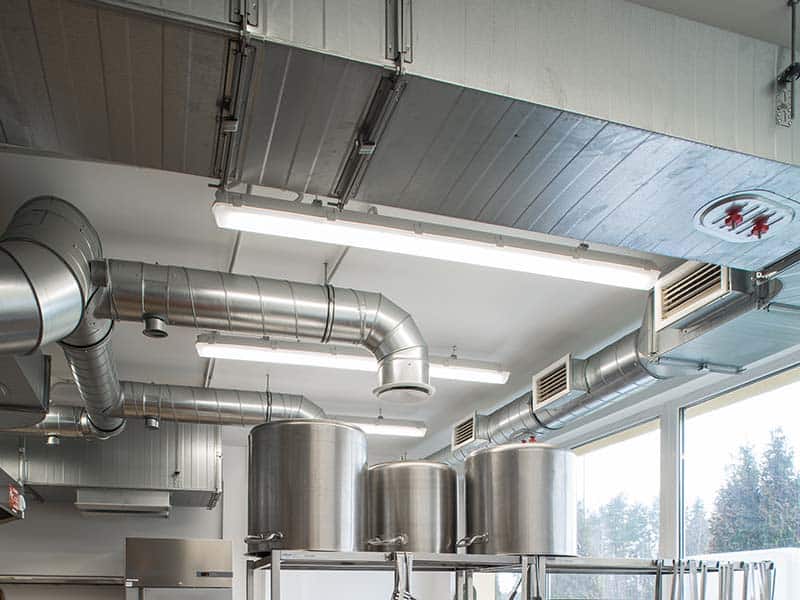
A solution to improve ventilation is emerging as an essential part of owning and managing a facility. In the past, many people thought of ventilation as important for industrial facilities and processes almost exclusively. Of course, circulating and filtering air has always been important for commercial facilities of any kind but the emphasis has grown dramatically during the COVID-19 pandemic.
How to Get Better Ventilation in a Room
By combining quality equipment like professional ventilation fans, ground-up design that takes a consultative approach to your team and facility, expert installation, and ongoing preventative maintenance, it is possible to improve the safety of your facility through HVAC.
Basic steps, like ensuring any individual rooms aren’t entirely isolated from the rest of the facility’s HVAC system, are important. Likewise, having the ductwork cleaned and filters changed regularly keeps the air quality in individual spaces consistent with the rest of the facility. All in all, though, the ideal way to ensure proper ventilation is to consider the entire facility.
A Holistic Approach to HVAC
Without considering exactly how a given facility will be used—considering occupancy, in-office foot traffic patterns, and other factors—it would be impossible to identify the perfect HVAC solution that would keep occupants healthy.
For instance, if an HVAC contractor came to visit your facility and simply looked at facts like square footage before procuring and then installing equipment, it’s likely that the system would, one, not operate as efficiently as possible and, two, would not appropriately address indoor air quality concerns.
Only through carefully calibrated controls, ventilation, and ongoing maintenance can a facility manager be confident that the system is meeting their needs. At React, we design, install, and maintain systems that meet or exceed standards set by local laws in New York.
How to Increase Airflow in a Room
Just as no two facilities are identical, and thus should not have exactly identical HVAC systems, no two rooms are the same. However, that doesn’t mean there aren’t best practices that you or your HVAC provider can use to improve the airflow in a room.
The novel coronavirus, and the countless other airborne pathogens out there we have grown accustomed to for years, all spread more easily in indoor spaces. This spread becomes a particular problem when the air is stagnant or turbulent.
You might be asking yourself, “Stagnant, turbulent… what are the other possibilities?” Stagnant air helps viruses spread because as people talk, cough, and sneeze, airborne particles have nowhere to go. Droplets and aerosolized particles that carry the coronavirus will drop to the floor eventually, but stagnant air creates what are essentially danger zones.
Turbulent flow results when air enters the room but is not removed in an efficient way. The result is air that circulates throughout the room unpredictably. This creates an ideal environment for airborne pathogens to hang in the air for long periods without being removed from the environment.
Proper HVAC design helps to create smooth airflow. A simple system of registers and air returns will add fresh air to the room and remove stale air. When these systems are designed properly, the flow of air through the room is smooth, helping to remove pathogens without recirculating them. In other words, to lower the concentration of viral particles in a room, proper airflow should be a top priority.
Hook: Ventilation that creates a smooth flow of air will remove pathogens from a room and create a safer, healthier environment for all those inside.
Designing a Proper Ventilation Solution
What are the specific airflow qualities you should strive to achieve through your ventilation system? While all of the details about how coronavirus spreads in the air have yet to be entirely fleshed out, there are some common qualities that are effective against viruses, bacteria, fungi, allergens, and all indoor air contaminants.
Vertical Laminar Flow – The idea here is that airflow is not only free of turbulence, but is also encouraged to travel up and toward air returns higher in the room. The direct path from floor to ceiling minimizes the spread of contaminants because it’s difficult or impossible for them to move across a room.
Slow and Steady Air Speed – Ideally, a room’s ventilation will not occur in short, violent bursts. That could create turbulence and actually help the spread of pathogens. Instead, a steady flow of air minimizes particulate concentration in the air and keeps people healthy.
Directing Contaminants Away – When air leaves a room, it should not be recirculated to the same room or anywhere else in the facility without first being filtered or cleansed somehow (UV lighting is an option here). Just because the air is moving doesn’t mean it’s safe, and carefully controlled ventilation systems only add clean air to rooms.
Are you confident that the ventilation in your building is meeting these criteria? Give React a call and we’ll ensure your HVAC is playing its proper role in keeping your team safe.